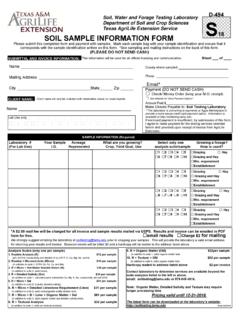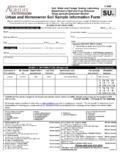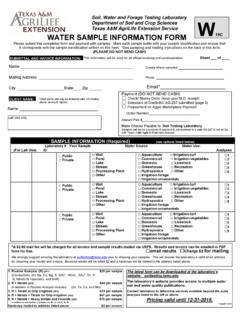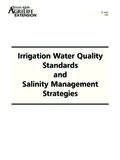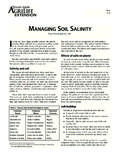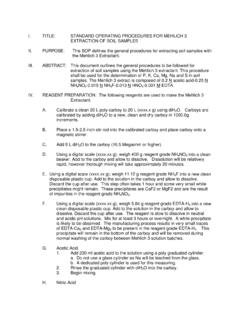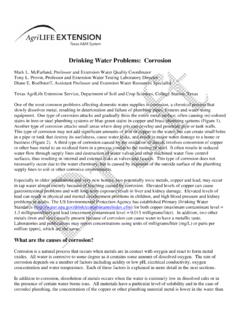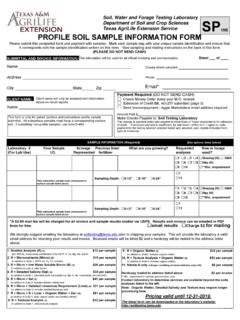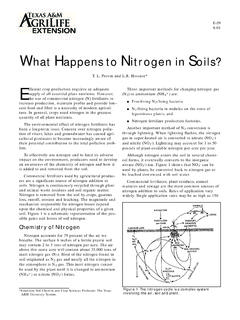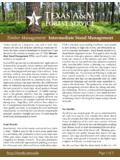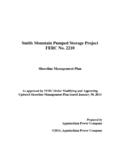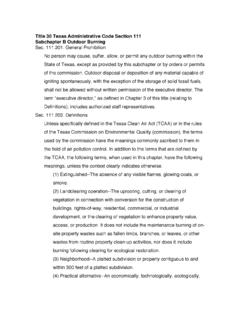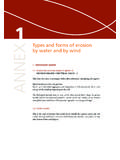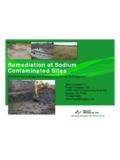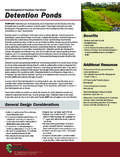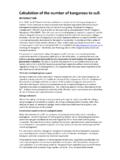Transcription of Pond Management Guide - Texas A&M University
1 ContentsIntroduction .. Planning and Pond Construction .. 3 Permits .. 3 Drainage Area .. 4 Water Source and Quality .. 4 Site Preparation .. 5 Size .. 5 Depth .. 5 Water Control Structure .. and Harvesting .. 7 Prestocking Procedures .. 7 Selecting the Proper Fish .. 8 Stocking Options .. 11 Mountain Trout ponds .. 12 Harvesting .. 13 Determining Balance .. Management ..17 Liming .. 17 Fertilization .. 18 Supplemental Feeding .. 20 Habitat Improvement .. Problems ..22 Fish Kills .. 22 Fish Parasites .. 23 Poor Fishing .. 24 Aquatic Weeds .. 24 Other Pond Problems .. of Additional Information .. 29 Pond Management GuidePond Management GuideNorth Carolina ponds are frequently fished by Tarheel anglers and represent asignificant portion of the state s water resource. Properly managed ponds canprovide excellent fishing opportunities to a large number of anglers at a reason-able cost.
2 However, it takes careful planning and wise Management to maintainhigh-quality fishing in a pond year after produce a good crop of fish every year, it is necessary to select the sitecarefully, construct the pond properly, maintain good water quality, and stockand harvest the pond correctly. Often the difference between a productive pondand an unproductive one is the ability of the owner to obtain sound pond man-agement advice and carry out the recommended constructing a pond, determine your objectives and priorities for thepond. The best Management strategy depends upon your objectives. Do youwant the pond to produce trophy bass or large quantities of average-sized bass?Do you want big bream (bluegills) or channel catfish? Will the pond be usedprimarily for irrigation, livestock watering, waterfowl, or recreation? Howheavily will the pond be fished?
3 How much money can you devote to achievingyour chosen objectives? You must answer these important questions during theinitial planning stages so you can develop a proper Management plan for publication presents the basic principles of managing recreational pondsand the requirements for producing and maintaining high-quality fishing in apond. Some common mistakes in pond Management and ways of solving pondproblems are discussed. This information should allow you to develop and carryout a pond Management plan that provides maximum Carolina Cooperative Extension Service 1 Site Planning and Pond ConstructionPerhaps the most important aspect of pond Management is deciding where andhow to build your pond. Many problems can be avoided if the pond is properlydesigned and constructed. The Natural Resources Conservation Service (NRCS)publication ponds Planning, Design, Construction (Agriculture Handbook 590)contains detailed information on design surveys, site selection, drainage area,pond layouts, soil analysis and spillway construction.
4 Contact your county NRCS office to obtain a copy. Your county NRCS staff can provide additional informa-tion on cost estimation and other aspects of pond construction, or refer you to areputable engineer for assistance. To take advantage of these services, contact theNRCS during the initial stages of pond are two general types of ponds : Watershed or embankment ponds , which are formed by constructing adam to collect stream or surface runoff, Excavated ponds , which are formed by digging down into the watertable in an area that is relatively type of pond that is best for your site will be determined to a great extentby the topography of the land and the principal use of the is usually necessary to move more earth to construct an excavated pond than awatershed (embankment) pond. Watershed ponds , however, are more likely to haveproblems with muddy water, high siltation rates, rapid fluctuations in flow rates,aquatic weeds, temperature fluctuations, and wild fish invasions.
5 Large watershedponds can benefit from construction of a small settling pond immediately upstreamto reduce turbidity, sedimentation, and weed problems in the large choosing a site, contact a representative of the Army Corps of Engi-neers to make sure that the site is not located in a wetland area, especially if thepond is to be of the watershed type. Streams are considered wetland areas. Ifpond construction involves placing a dam across a stream or affects a wetland inother ways, you are required by law to obtain a 404 permit from the Corps ofEngineers before starting permits may also be required for certain types of watershed the dam height will exceed 15 feet and impounded water volume (at the damcrest) will exceed 10 acre-feet, or if the dam is deemed to be a high hazardstructure that would cause significant property damage or loss of life uponfailure, you are required to obtain two additional permits (one for constructionNorth Carolina Wildlife Resources Commission4 Pond Management Guideand one for impoundment of water) from the North Carolina Department ofEnvironment and Natural Resources (DENR) Dam Safety Program.
6 The agencymay also require that you prepare a sediment and erosion control plan to preventexcessive siltation if a stream is being impounded during construction. To ensurethat your pond will conform to all state laws, contact the DENR Dam SafetyProgram (919-733-4574) or your nearest regional DENR office before beginningconstruction. Also check to see if local county or municipal ordinances requireadditional AreaAn important factor in deciding where to build a pond is the nature of the sur-rounding watershed or drainage area. Generally, a watershed pond built inpastureland requires 5 to 20 acres of watershed per surface acre of pond, whereas apond constructed in woodland requires 20 to 40 acres. If the drainage area is toolarge, it may be necessary to construct a diversion ditch to channel excess wateraround the pond. If the drainage area is insufficient, the pond will not fill ad-equately and will be subject to water-level fluctuations and vegetation Source and QualityPotential water sources for a pond include surface runoff, streams, springs, andwells.
7 Each source has advantages and disadvantages; the type chosen willdepend to a large extent on where the pond is located. Surface runoff is rarely asource of disease or wild fish problems but leads to fluctuations in pond levelduring spring and fall. Streams are usually high in dissolved oxygen, but theyalso tend to fluctuate rapidly, are a source of silt, and are a potential source ofdiseases and wild fish are considered the most desirable water source because they have aconstant temperature and flow rate, are very inexpensive to divert, are rarely asource of disease or wild fish problems, and are less likely to be affected bypollution. However, they may contain high concentrations of undesirable gases(hydrogen sulfide and carbon dioxide), and the high clarity of the water frommost springs encourages vegetation problems.
8 Wells offer good quality water andcan be placed where convenient, but are expensive to drill and is also important to consider land uses within the watershed where the pondis located, as these may degrade the water quality. Runoff from cropland canincrease the amount of sediment reaching the pond and may cause turbidity. Itmay also contain potentially toxic agricultural chemicals, as well as fertilizersthat can cause algal blooms and resultant fish kills. Runoff from pastures andlivestock holding areas is rich in nutrients (animal wastes) that can also causealgal blooms and fish kills. Residential, urban, and industrial runoff may containsubstances (such as industrial waste, chemicals, oils, and sediment from con-struction activities) that can adversely affect a pond s water quality. Whenplanning a pond, therefore, be sure to consider the quality of the water sourceand factors that may affect Carolina Cooperative Extension ServiceSite PreparationDuring construction of ponds to be used primarily for fishing, remove all brush,trees, and vegetation from near-shore areas of the pond before it is filled, so thepond can be seined to remove excess sunfish if necessary.
9 If desired, habitatstructures like stumps, logs, brush piles or standing bushes can be left in someareas of the pond to provide cover for small fish and attract larger fish foranglers. To prevent soil erosion, revegetate the dam and pond banks as soon aspossible after construction has been completed. New ponds should be filled byearly to mid-fall to coincide with the best period for stocking best fishing ponds have a surface area of at least 1 acre. ponds of less than 1acre are difficult to manage because the fish populations, especially largemouthbass, are easily overharvested. In addition, small, shallow ponds are susceptibleto vegetation problems that usually result in overpopulation of sunfish. Theseproblems ultimately result in stunted growth of both bass and sunfish. The fishpopulations in ponds of less than 1 acre are also adversely affected by you have a small pond and cannot afford to enlarge it, the best managementtactic is to stock it with a single species of fish, such as channel catfish or hybridsunfish, and begin a feeding program (discussed in a later section).
10 DepthThe average depth for a 1-acre or larger fish pond should be between 6 and 8feet with a maximum depth not greater than 10 to 12 feet. An average depth lessthan 6 feet greatly increases the probability of aquatic vegetation becomingestablished in the pond. Depths greater than 12 feet are not necessary for goodfish production and increase the chance of fish kills from summertime oxygendepletion. Pond banks should be cut on a 3-to-1 slope and should be a mini-mum of 3 feet deep at the waterline before leveling off (Figure 1). This shapewill help prevent the growth of nuisance aquatic vegetation and will alsodiscourage Control StructureAn important feature that should be incorporated into the design of all fishponds greater than 1 acre is a water control structure (drainpipe). A drainpipeenables you to drain the pond to make repairs, fix leaks, and control nuisanceaquatic vegetation.
